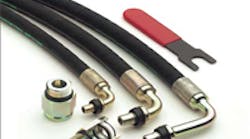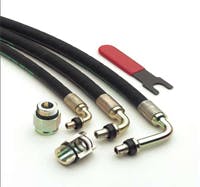The best way to eliminate leaks is to eliminate the places where they happen, and in fluid power that would mean eliminating fittings and connectors. Unfortunately, connectorless systems simply aren’t feasible in the real world.
Brazed fittings have been the industry standard for many years, but they're far from perfect. The technology depends on holding close tolerances for the size of tube and fitting, getting exactly the right amount of brazing material into the joint, and applying exactly the right amount of heat. Brazing is as much art as science, and even some factory-made brazed joints can pose a challenge to design engineers. Brazed joints are also labor-intensive to install and easily damaged by overeager workers.
Brazed joints have a place in the hydraulic universe, but they are being replaced by newer technologies.
The solid solution
The idea of making the connector an integral part of the tube line offers great potential for both eliminating leaks and simplifying both installation and maintenance. Mechanical forming involves the use of highly engineered tooling used in conjunction with pressure to produce the desired end forms and dimensions. Good engineering practices and design principles are required for the development of a mechanical forming process.
Forming a threadless connector, for example, requires anywhere from three to six different steps to achieve the required precision and consistency. The equipment used is highly specialized and extremely precise.
The equivalent of the brazed connector mentioned previously is produced in a six-step automated end-forming process using specially developed tooling and process parameters. Process development included extensive CAD modeling and FMEA analysis prior to prototype production. Along the way, minor changes had to be made to the formed profiles to accommodate the process.
Initial prototype parts were made in a two-step process, which introduced uncontrolled variations in the parts. As a result, the process was re-worked to finish the forms in a single clamping on a Wauseon ram-type end former. Additional modifications were required to compensate for variations in the welded, drawn, and annealed tubing used in the process.
Obviously, the expense of developing and tooling a process like this is only justified for relatively high-volume products. Still, the advantages of formed connectors make the investment worthwhile for a wide range of components. Foremost among these advantages is the elimination of human error and process variation in the forming operation, producing a consistent connection that is highly leak-resistant.
Capable of working pressures up to 5000 psi in sizes 1 in., STC threadless connectors are most commonly used as male fittings on hoses and tubing.
Significant cost reductions
Replacing a brazed male threadless connector with a formed male STC connector reduces manufacturing time by 80%. As we have seen, 12 manufacturing steps are needed to create a brazed male spud on a tube, while the formed fitting requires only six, and those are highly automated. Reduced manufacturing time also shortens lead-time and improves delivery of finished goods to the end customer.
One result of these economies and the ease of installation of formed fittings is that hose and tube assemblies are becoming more and more prevalent in the fluid power industry. In addition to easier installation, they provide resistance to vibration, reduction in the overall number of connections and, therefore, fewer opportunities for fluid leakage.
High-pressure applications
Formed fittings can also be produced in tubing intended for higher-pressure applications using O-ring seal (ORS) technology. In addition to reduced leakage and quicker product turnaround, formed ORS ends also provide a performance benefit by extending the product’s flex life. Some formed ORS ends can even pass the ASTM F1387, A10 rotary flex test. Formed product will meet one million cycles; while brazed ORS may fail well below the minimum required flex cycles.
Forming the heavier, higher-strength tubing used in hydraulic applications is much more difficult than forming low-pressure, low-carbon steel tubes, but it can be done effectively. These connectors are typically produced by a combination of rotary forming and ram-type tooling. This does not mean the forming equipment has to be massive, however. Eaton and some other manufacturers supply small forming systems to distributors and dealers which can be used to produce high-pressure formed fittings in the field. For even higherpressure applications, a European-developed technology is available to form high-pressure tube ends to eliminate the need for a cutting ring in the joint. The resulting joint offers both a primary captive seal, and a secondary metal-to-metal seal. The Walform Plus process offers joints with fewer components and fewer leak paths. It can be applied on tubes from 6 to 42 mm in systems operating at pressures up to 11,600 psi with a 4:1 burst rating.
Scott Campbell is with the Eaton Hydraulics's Aeroquip Div., Maumee, Ohio. for more informatin, visit www.eaton.com/hydraulics.


